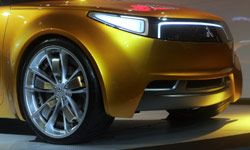By almost all accounts, the days of abundantly cheap gasoline are over. But we're not necessarily doomed to suffer fuel price fatigue into eternity. By 2025, it's quite possible that the average passenger automobile will be capable of getting more than 50 miles per gallon (21.3 kilometers per liter) — if it runs on conventional fuel at all.
Making it to that mark will come neither easily nor cheaply. Fortunately, the engineers and scientists tasked with the goal of making automobiles more efficient have a few tricks left up their collective sleeve.
Advertisement
One of the biggest areas available in which to make gains is in reducing the mass of cars and trucks — a broad discipline known as automotive lightweighting. Lightweighting seeks to shave pounds from the overall weight of a vehicle by using advanced materials, ingenious construction and novel systems. It's been estimated that every 10 percent of weight reduction yields a decrease of between 6 and 7 percent in fuel consumption. So even small weight savings — when multiplied by the thousands of parts on a typical vehicle — can up add to significant amounts.
This trend has actually been in progress for decades: The average sedan today weighs 3,000 pounds (1,361 kilograms), compared to 4,500 pounds (2,041 kilograms) 30 years ago. That's despite the steady growth in gizmos, safety features and creature comforts that have made our vehicles like rolling homes and offices over the years. Continuing to make vehicles lighter depends on taking smart approaches to making their component parts lighter.
In the next few pages, we'll cover five of the smartest innovations that will make, and in some cases are right now making auto parts lighter.
